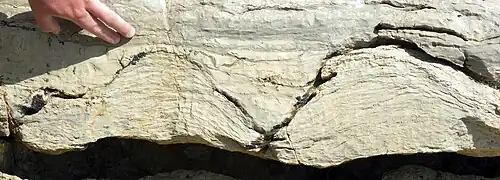| Pika Formation | |
|---|---|
| Stratigraphic range: Middle Cambrian ~ | |
 | |
| Type | Formation |
| Underlies | Arctomys Formation, Deadwood Formation, or Sullivan Formation |
| Overlies | Eldon Formation, Titkana Formation, or Earlie Formation |
| Thickness | Up to 361 metres (1,184 ft)[1] |
| Lithology | |
| Primary | Calcareous mudstone |
| Other | Limestone, dolomite |
| Location | |
| Coordinates | 51°29′40″N 116°06′05″W / 51.49444°N 116.10139°W |
| Region | Canadian Rockies |
| Country | |
| Type section | |
| Named for | Pika Peak |
| Named by | C.F. Deiss, 1939[2] |
The Pika Formation is a stratigraphic unit of Middle Cambrian age that is present on the western edge of the Western Canada Sedimentary Basin in the Canadian Rockies of Alberta and British Columbia.[3] It was named for Pika Peak near Lake Louise in Banff National Park by C.F. Deiss in 1939.[2] It is fossiliferous and preserves several genera of trilobites.[4] Outcrops of the Pika Formation can be seen in Banff and Jasper National Parks.[5]
Lithology and deposition
The Pika Formation consists primarily of dark-weathering, thin-bedded calcareous mudstone with thin dolomitized partings. There are minor intervals of shale near the base.[1][3] The Pika was deposited in shallow marine environments along the western margin of the North American Craton during Middle Cambrian time.[3][4][6][7]
Distribution and stratigraphic relationships
The Pika Formation is present in the Rocky Mountains of Alberta and British Columbia, from south of Mount Assiniboine to the Kakwa area in the north. It thickens westward, reaching a maximum thickness of about 361 metres (1,184 feet) near the Chaba River, and thins to zero in the subsurface of the Alberta plains. It is in gradational contact with the underlying Eldon Formation in the south, Titkana Formation in the north, and the Earlie Formation in the east. In the mountains it is overlain by the Arctomys Formation; the contact is abrupt and may be unconformable. In the plains to the east it is unconformably overlain by the Sullivan Formation or, farther east, by the Deadwood Formation.[1][3][8]
References
- 1 2 3 Glass, D.J. (editor) 1997. Lexicon of Canadian Stratigraphy, vol. 4, Western Canada including eastern British Columbia, Alberta, Saskatchewan and southern Manitoba. Canadian Society of Petroleum Geologists, Calgary, 1423 p. on CD-ROM. ISBN 0-920230-23-7.
- 1 2 Deiss, C.F. 1939. Cambrian formations of southwestern Alberta and southeastern British Columbia. Geological Society of America Bulletin, vol. 50, p. 951-1019.
- 1 2 3 4 Slind, O.L., Andrews, G.D., Murray, D.L., Norford, B.S., Paterson, D.F., Salas, C.J., and Tawadros, E.E., Canadian Society of Petroleum Geologists and Alberta Geological Survey (1994). "The Geological Atlas of the Western Canada Sedimentary Basin (Mossop, G.D. and Shetsen, I., compilers), Chapter 8: Middle Cambrian and Early Ordovician Strata of the Western Canada Sedimentary Basin". Archived from the original on 2016-07-01. Retrieved 2018-07-13.
{{cite web}}: CS1 maint: multiple names: authors list (link) - 1 2 Melzak, A. and Westrop, S.R. 1994. Mid-Cambrian (Marjuman) from the Pika Formation, southern Canadian Rocky Mountains, Alberta. Canadian Journal of Earth Sciences, vol. 31, p. 969-985.
- ↑ Leckie, D.A. 2017. Rocks, ridges and rivers – Geological wonders of Banff, Yoho, and Jasper National Parks. Brokenpoplars, Calgary, Alberta, 217 pp. ISBN 978-0-9959082-0-8.
- ↑ Aitken, J.D. 1966. Middle Cambrian to Middle Ordovician cyclic sedimentation, southern Rocky Mountains of Alberta. Bulletin of Canadian Petroleum Geology, vol. 14, no. 6, p. 405-441.
- ↑ Aitken, J.D. 1997. Stratigraphy of the Middle Cambrian platformal succession, southern Rocky Mountains. Geological Survey of Canada, Bulletin 398, 322 p.
- ↑ Alberta Geological Survey. "Alberta Table of Formations, May 2019" (PDF). Alberta Energy Regulator. Retrieved 24 March 2020.